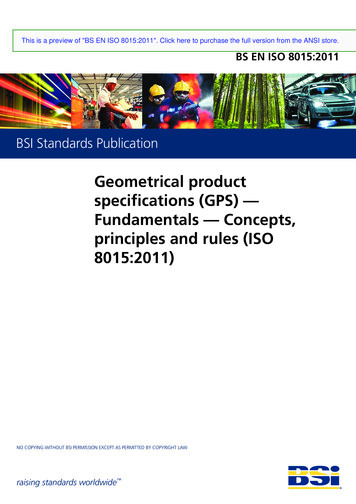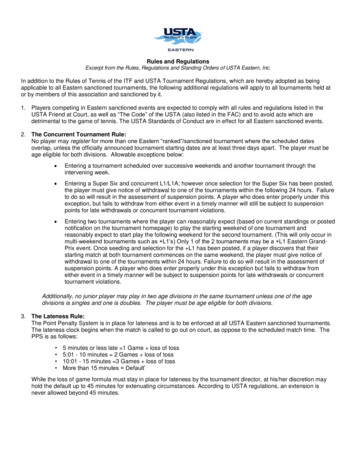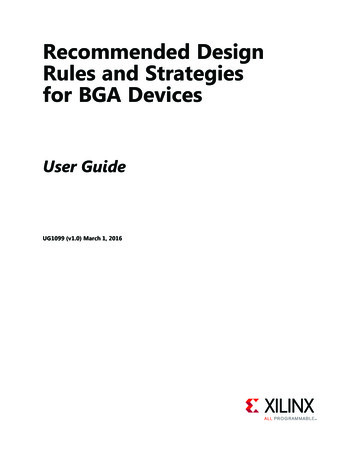
Transcription
This is a preview of "BS EN ISO 8015:2011". Click here to purchase the full version from the ANSI store.BS EN ISO 8015:2011BSI Standards PublicationGeometrical productspecifications (GPS) —Fundamentals — Concepts,principles and rules (ISO8015:2011)NO COPYING WITHOUT BSI PERMISSION EXCEPT AS PERMITTED BY COPYRIGHT LAWraising standards worldwide
BS EN ISO 8015:2011BRITISH STANDARDThis is a preview of "BS EN ISO 8015:2011". Click here to purchase the full version from the ANSI store.National forewordThis British Standard is the UK implementation of EN ISO 8015:2011.It supersedes BS ISO 8015:1985 which is withdrawn.BSI, as a member of CEN, is obliged to publish EN ISO 8015:2011 as aBritish Standard. However, attention is drawn to the fact that duringthe development of this European Standard, the UK committeevoted against its approval as a European Standard. The reason forthe negative vote is the wording of clause 5.1 where the indication"Tolerancing ISO 8015" is optional. It is the UK committee's opinionthat this indication should always be invoked in the marking of aTechnical Product Specification which will be interpreted in accordance with ISO GPS systems. The UK participation in its preparationwas entrusted to Technical Committee TDW/4, Technical ProductRealization.A list of organizations represented on this committee can beobtained on request to its secretary.This publication does not purport to include all the necessaryprovisions of a contract. Users are responsible for its correctapplication. BSI 2011ISBN 978 0 580 70480 2ICS 01.100.20Compliance with a British Standard cannot confer immunity fromlegal obligations.This British Standard was published under the authority of theStandards Policy and Strategy Committee on 30 September 2011.Amendments issued since publicationDateText affected
EN ISO 8015EUROPEAN STANDARDThis is a preview of "BS EN ISO 8015:2011". Click here to purchase the full version from the ANSI store.NORME EUROPÉENNEEUROPÄISCHE NORMJune 2011ICS 01.100.20English VersionGeometrical product specifications (GPS) - Fundamentals Concepts, principles and rules (ISO 8015:2011)Spécification géométrique des produits (GPS) - Principesfondamentaux - Concepts, principes et règles (ISO8015:2011)Geometrische Produktspezifikation (GPS) - Grundlagen Konzepte, Prinzipien und Regeln (ISO 8015:2011)This European Standard was approved by CEN on 18 May 2011.CEN members are bound to comply with the CEN/CENELEC Internal Regulations which stipulate the conditions for giving this EuropeanStandard the status of a national standard without any alteration. Up-to-date lists and bibliographical references concerning such nationalstandards may be obtained on application to the CEN-CENELEC Management Centre or to any CEN member.This European Standard exists in three official versions (English, French, German). A version in any other language made by translationunder the responsibility of a CEN member into its own language and notified to the CEN-CENELEC Management Centre has the samestatus as the official versions.CEN members are the national standards bodies of Austria, Belgium, Bulgaria, Croatia, Cyprus, Czech Republic, Denmark, Estonia,Finland, France, Germany, Greece, Hungary, Iceland, Ireland, Italy, Latvia, Lithuania, Luxembourg, Malta, Netherlands, Norway, Poland,Portugal, Romania, Slovakia, Slovenia, Spain, Sweden, Switzerland and United Kingdom.EUROPEAN COMMITTEE FOR STANDARDIZATIONCOMITÉ EUROPÉEN DE NORMALISATIONEUROPÄISCHES KOMITEE FÜR NORMUNGManagement Centre: Avenue Marnix 17, B-1000 Brussels 2011 CENAll rights of exploitation in any form and by any means reservedworldwide for CEN national Members.Ref. No. EN ISO 8015:2011: E
BS EN ISO 8015:2011EN ISO 8015:2011 (E)This is a preview of "BS EN ISO 8015:2011". Click here to purchase the full version from the ANSI store.ForewordThis document (EN ISO 8015:2011) has been prepared by Technical Committee ISO/TC 213 “Dimensionaland geometrical product specifications and verification” in collaboration with Technical CommitteeCEN/TC 290 “Dimensional and geometrical product specification and verification” the secretariat of which isheld by AFNOR.This European Standard shall be given the status of a national standard, either by publication of an identicaltext or by endorsement, at the latest by December 2011, and conflicting national standards shall be withdrawnat the latest by December 2011.Attention is drawn to the possibility that some of the elements of this document may be the subject of patentrights. CEN [and/or CENELEC] shall not be held responsible for identifying any or all such patent rights.According to the CEN/CENELEC Internal Regulations, the national standards organizations of the followingcountries are bound to implement this European Standard: Austria, Belgium, Bulgaria, Croatia, Cyprus, CzechRepublic, Denmark, Estonia, Finland, France, Germany, Greece, Hungary, Iceland, Ireland, Italy, Latvia,Lithuania, Luxembourg, Malta, Netherlands, Norway, Poland, Portugal, Romania, Slovakia, Slovenia, Spain,Sweden, Switzerland and the United Kingdom.Endorsement noticeThe text of ISO 8015:2011 has been approved by CEN as a EN ISO 8015:2011 without any modification.3
BS EN ISO 8015:2011ISO 8015:2011(E)This is a preview of "BS EN ISO 8015:2011". Click here to purchase the full version from the ANSI store.ContentsPageForeword .ivIntroduction.v1Scope .12Normative references.13Terms and definitions .144.14.24.34.4Fundamental assumptions for the reading of specifications on drawings.2General .2Functional limits .2Tolerance limits .2Workpiece functional level amental principles .2Invocation principle.2Principle of GPS standard hierarchy.3Definitive drawing principle .3Feature principle.4Independency principle .4Decimal principle.4Default principle .4Reference condition principle .5Rigid workpiece principle .5Duality principle.5Functional control principle .5General specification principle .6Responsibility principle .666.16.26.3Rules for indication of default specification operators.6General .6General ISO default GPS specification .6Altered default GPS specification.777.17.2Rules for indication of special specification operators .8General .8Added complementary information (requirements) to the ISO basic specification .88Rules for statements in parentheses .8Annex A (informative) Relation to the GPS matrix model.9Bibliography.10 ISO 2011 – All rights reservediii
BS EN ISO 8015:2011ISO 8015:2011(E)This is a preview of "BS EN ISO 8015:2011". Click here to purchase the full version from the ANSI store.ForewordISO (the International Organization for Standardization) is a worldwide federation of national standards bodies(ISO member bodies). The work of preparing International Standards is normally carried out through ISOtechnical committees. Each member body interested in a subject for which a technical committee has beenestablished has the right to be represented on that committee. International organizations, governmental andnon-governmental, in liaison with ISO, also take part in the work. ISO collaborates closely with theInternational Electrotechnical Commission (IEC) on all matters of electrotechnical standardization.International Standards are drafted in accordance with the rules given in the ISO/IEC Directives, Part 2.The main task of technical committees is to prepare International Standards. Draft International Standardsadopted by the technical committees are circulated to the member bodies for voting. Publication as anInternational Standard requires approval by at least 75 % of the member bodies casting a vote.Attention is drawn to the possibility that some of the elements of this document may be the subject of patentrights. ISO shall not be held responsible for identifying any or all such patent rights.ISO 8015 was prepared by Technical Committee ISO/TC 213, Dimensional and geometrical productspecifications and verification.This second edition cancels and replaces the first edition (ISO 8015:1985), which has been technically revised.iv ISO 2011 – All rights reserved
BS EN ISO 8015:2011ISO 8015:2011(E)This is a preview of "BS EN ISO 8015:2011". Click here to purchase the full version from the ANSI store.IntroductionThis International Standard is a geometrical product specification (GPS) standard and is to be regarded as afundamental GPS standard (see ISO/TR 14638). It influences all other standards in the GPS matrix system,i.e. all global, general and supplementary standards, as well as any other kind of document in the GPS matrixsystem.For more detailed information of the relation of this International Standard to other standards and the GPSmatrix model, see Annex A.This International Standard covers a number of fundamental principles that apply to all GPS standards andtechnical product documentation that is based on the GPS matrix system. Until this current version of thisInternational Standard was published, these principles were implied, but not formulated explicitly.This International Standard also covers the indication of ISO default specification operators and particularlythe indication of non-default specification operators, either by direct indication or by the use of companyspecific or drawing-specific defaults.For the purpose of this International Standard, a concept is considered as an abstract idea, a principle isconsidered as a standardized truth based on concepts upon which rules are based, and a rule is consideredas a standardized procedure (for action). ISO 2011 – All rights reservedv
BS EN ISO 8015:2011This is a preview of "BS EN ISO 8015:2011". Click here to purchase the full version from the ANSI store.
BS EN ISO 8015:2011INTERNATIONAL STANDARDISO 8015:2011(E)This is a preview of "BS EN ISO 8015:2011". Click here to purchase the full version from the ANSI store.Geometrical product specifications (GPS) — Fundamentals —Concepts, principles and rules1ScopeThis International Standard specifies fundamental concepts, principles and rules valid for the creation,interpretatio
It supersedes BS ISO 8015:1985 which is withdrawn. BSI, as a member of CEN, is obliged to publish EN ISO 8015:2011 as a British Standard. However, attention is drawn to the fact that during the development of this European Standard, the UK committee voted against its approval as a European Standard. The reason for the negative vote is the wording of clause 5.1 where the indication











